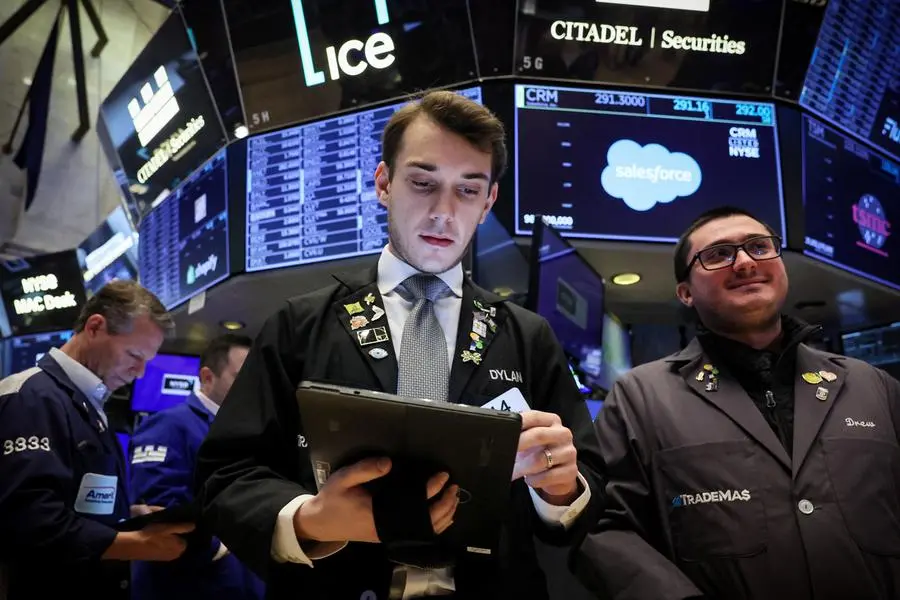PHOTO
NEW YORK - Popular funds that sell options for income may be moderating the recent bout of volatility in U.S. stocks, extending the calming effect they have had on the market for the last several months.
Assets under derivative income ETFs, funds that use a mix of stock and stock derivatives to generate income, have grown to about $71 billion from $33 billion at the end of 2022, according to Morningstar data.
Some options mavens believe these funds and other options-selling strategies have tempered stock gyrations, another reason equity markets have enjoyed a long period of calm. The Cboe Volatility Index, Wall Street's "fear gauge", in late March fell to its lowest in two months, as strong earnings and expectations of rate cuts this year sent stocks marching higher.
The trades may also have moderated recent volatility as the VIX has climbed to hover near a seven-week high of 16.92 hit on Friday, on mounting worries the Federal Reserve may not deliver as many rate cuts as expected without an inflationary rebound.
The S&P 500 stands near record highs, yet it logged two straight days of 1% swings last week, the first such move in about two months.
While several factors may have kept volatility from flaring even higher, the presence of volatility-selling funds was one moderating force, said Alex Kosoglyadov, managing director for equity derivatives at Nomura.
"There's been tremendous growth in these ETFs, QIS (Quantitative Investment Strategies) and in mutual fund strategies that have been selling options for income," Kosoglyadov said. "We see it every day. It definitely has a pronounced impact on the market."
Options selling strategies come in various forms, including ones that may sell calls, puts or a combination of these, with or without equity holdings. Their diversity makes it difficult to assess the exact market impact they might have on a given day. Taken together, however, they moderate market swings.
For example, some options selling ETFs generate income by selling out of the money call options - contracts with strike prices well above where the market may be trading - against their stock holdings.
Market makers - institutional players such as big banks - taking the other side of these trades often hedge their exposure to the bullish contracts by selling stock index futures. When markets grind higher, as they have in recent months, the ETFs are forced to buy back the call options they sold, prompting market makers to close their own hedges by buying index futures, thereby supporting stocks.
"That's one of the reasons why you have seen volatility so low over the last few years," Kris Sidial, co-chief investment officer of volatility arbitrage fund the Ambrus Group.
Every jump in volatility has been met with a "massive wave of supply of index volatility," Sidial said.
While these options-selling strategies work in the background to temper market moves, they alone would probably not prevent a selloff if the outlook for stocks radically changes, said UBS equity derivatives strategist Maxwell Grinacoff.
"To me it's the cherry on top in terms of why has volatility been so low," Grinacoff said.
One potential flashpoint comes on Wednesday, when the U.S. will report consumer price data for March.
A higher than expected reading could exacerbate inflation fears and further undermine the case for interest rate cuts - a key driver of the bull market that has boosted the S&P 500 about 26% above its October 2023 lows.
The short volatility trade has a checkered track record on Wall Street. In February 2018, a volatility-tracking note called the VelocityShare Daily Inverse VIX Short Term ETN went bust as market volatility surged in an event dubbed “Volmageddon,” which erased nearly $2 billion in investor assets.
Grinacoff and other options market participants are skeptical the current crop of options-selling funds pose the same sort of systemic risk since they are structured differently and less concentrated in their positioning than past funds.
Still, some market participants worry about what might happen if these strategies were to be hastily unwound.
"When volatility increases, and you're dealing with derivatives, it's always difficult to know what will be impacted when," said Ed Clissold, chief U.S. strategist at Ned Davis Research.
(Reporting by Saqib Iqbal Ahmed and Suzanne McGee; Additional reporting by Laura Matthews; Editing by Ira Iosebashvili and David Gregorio)























